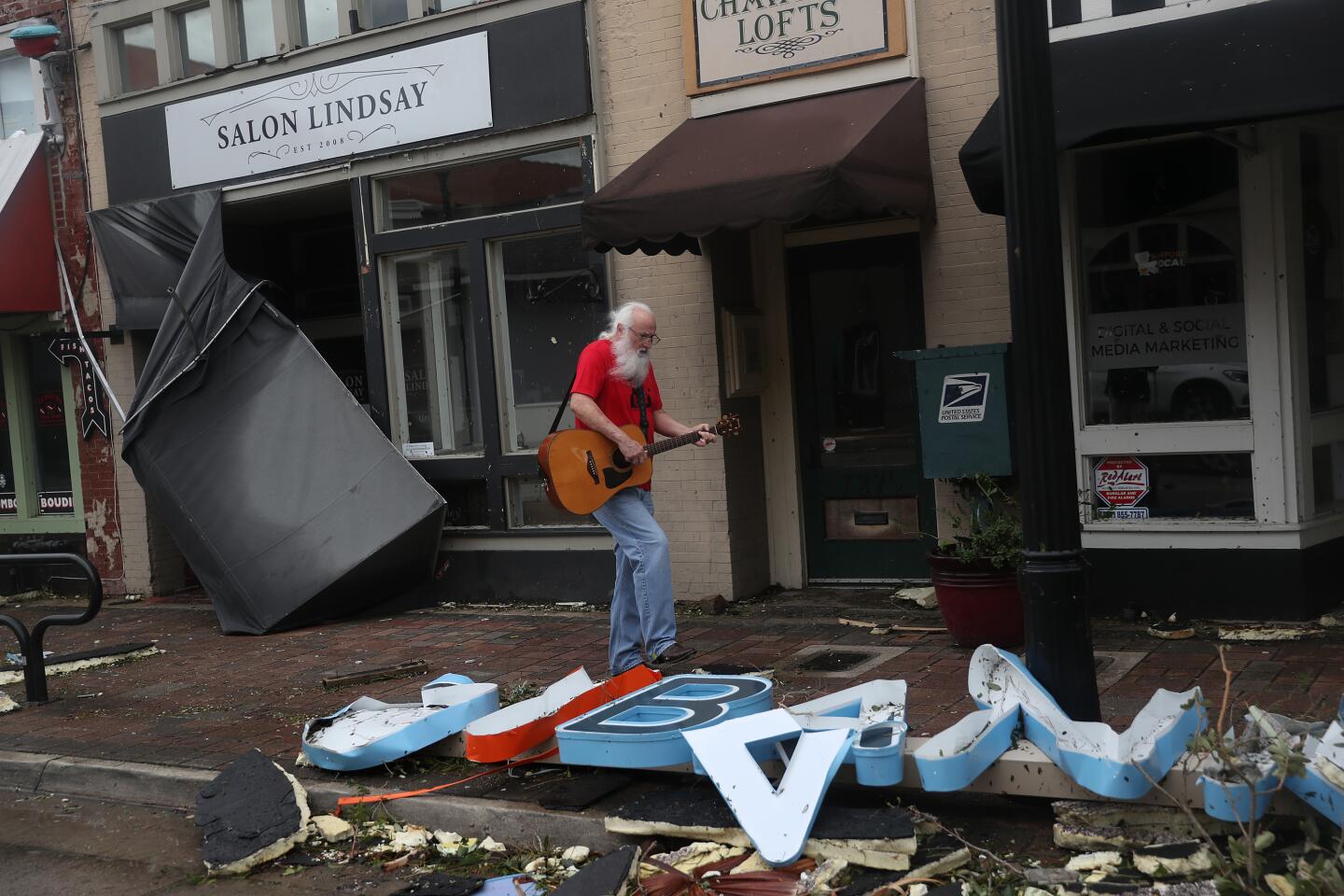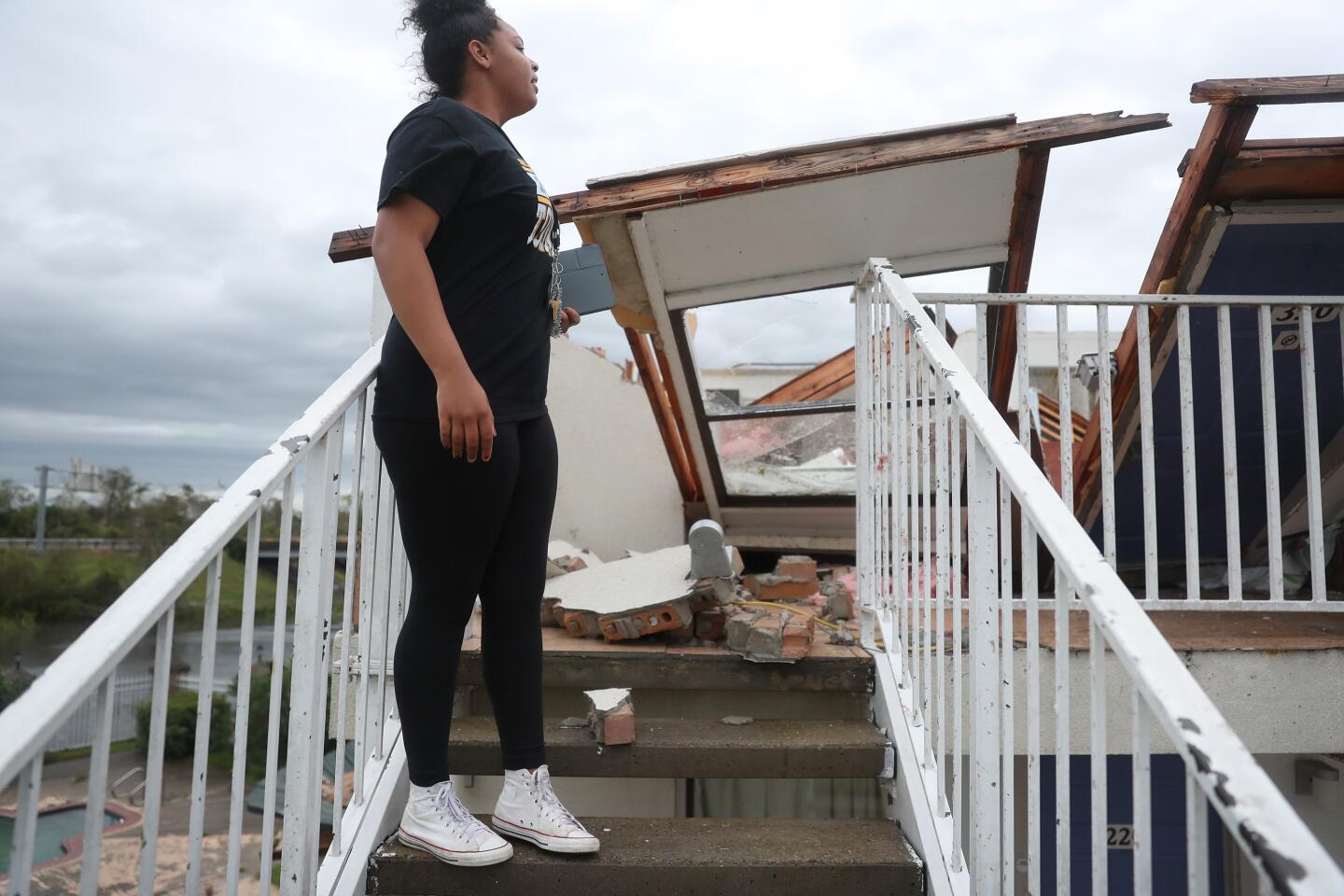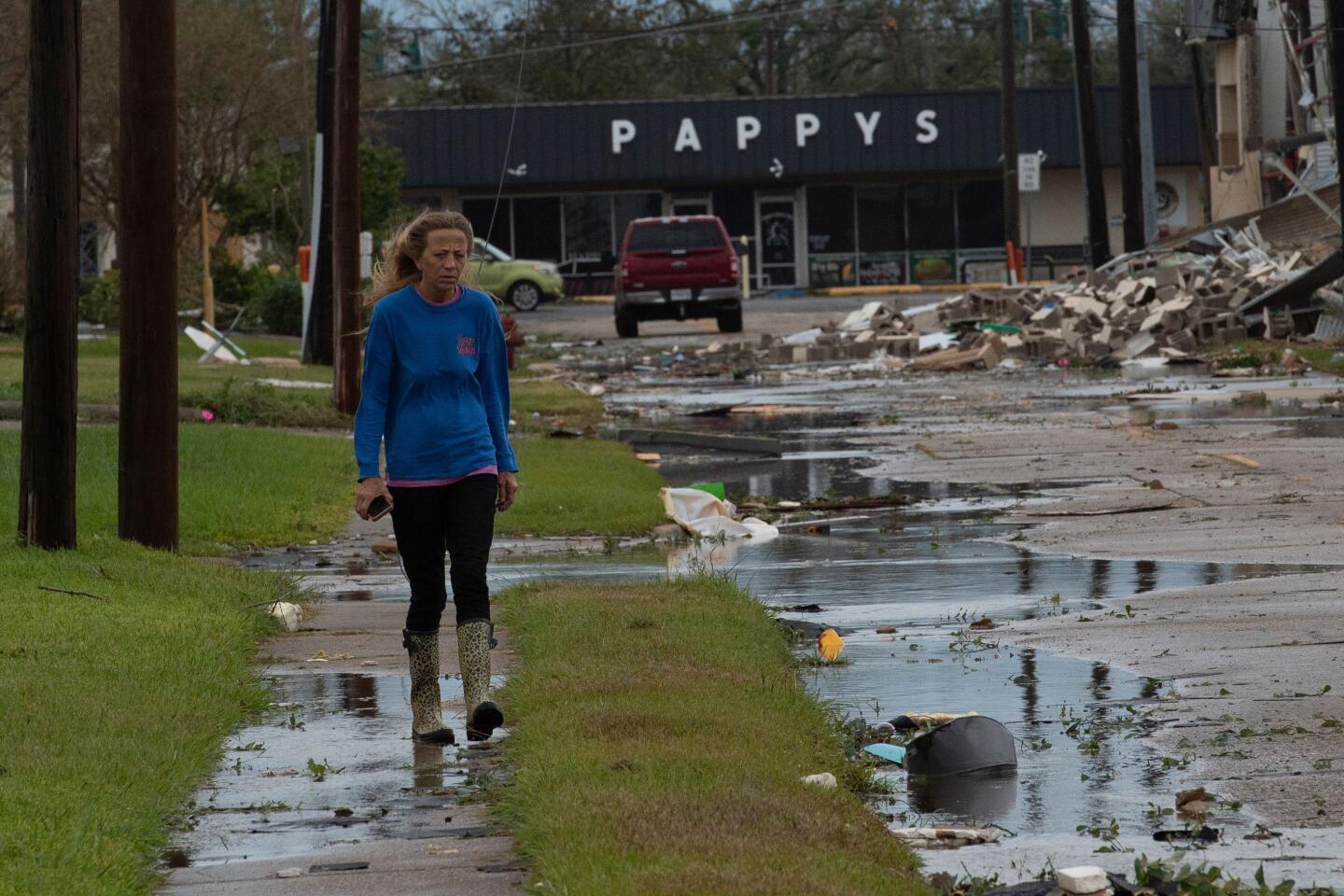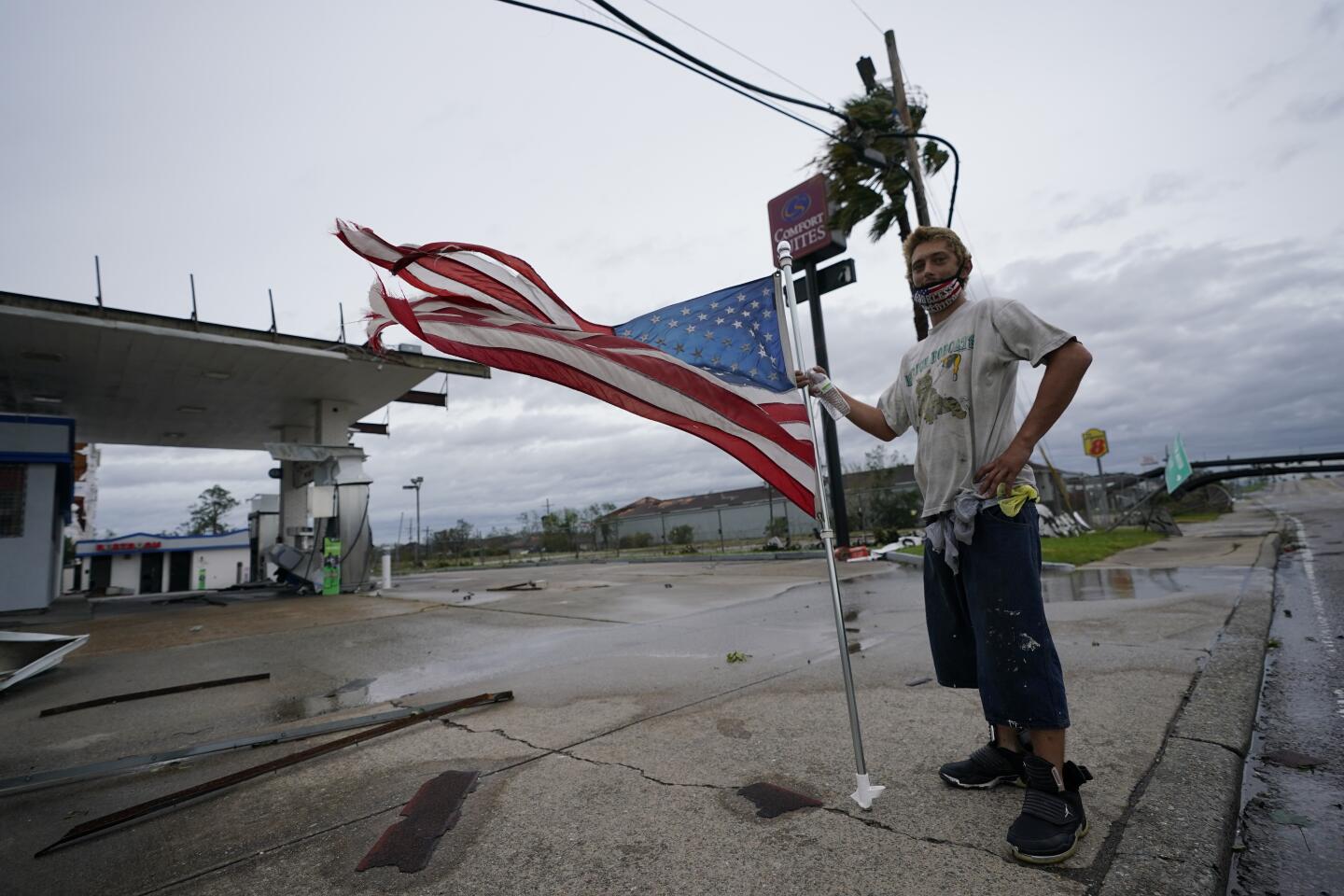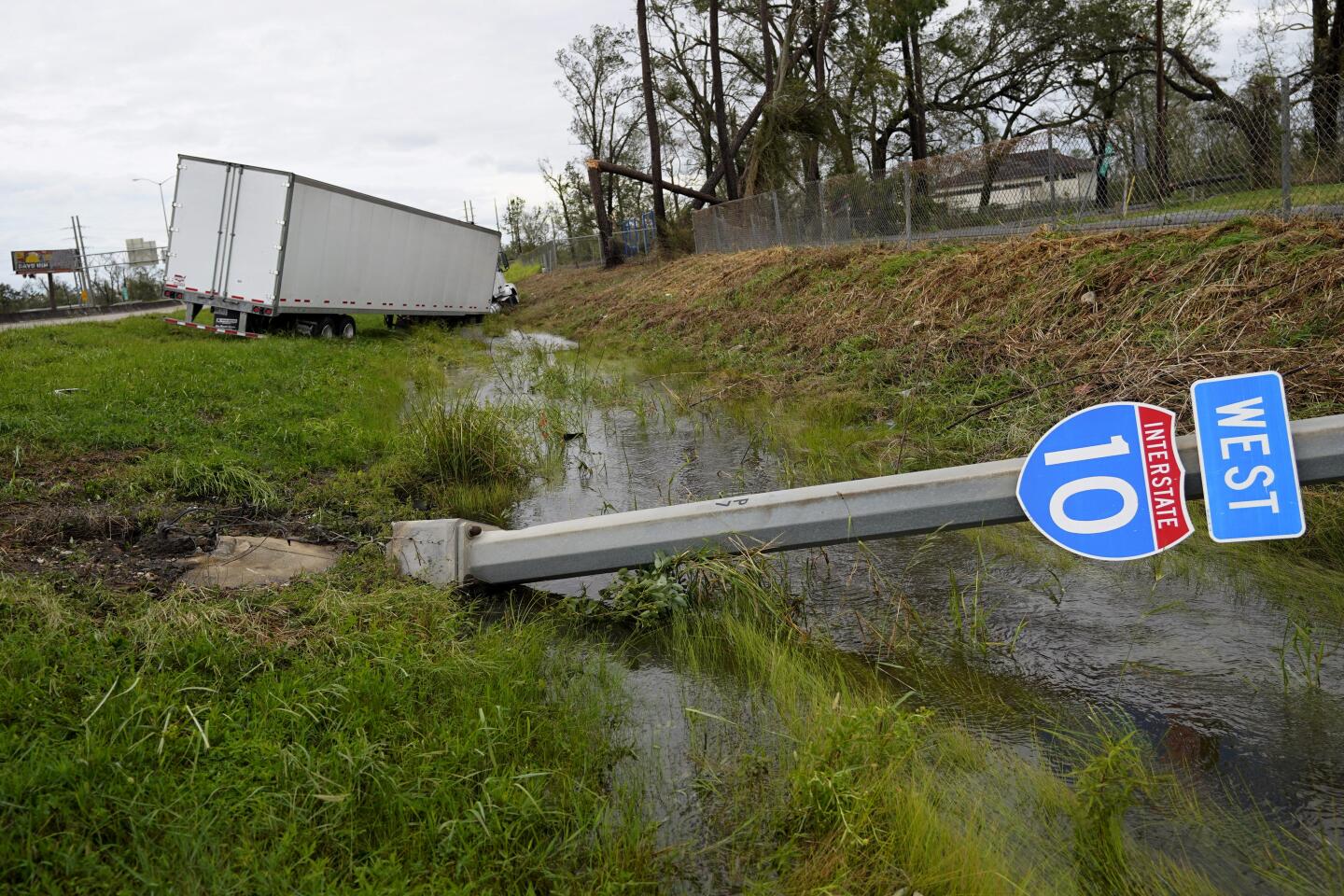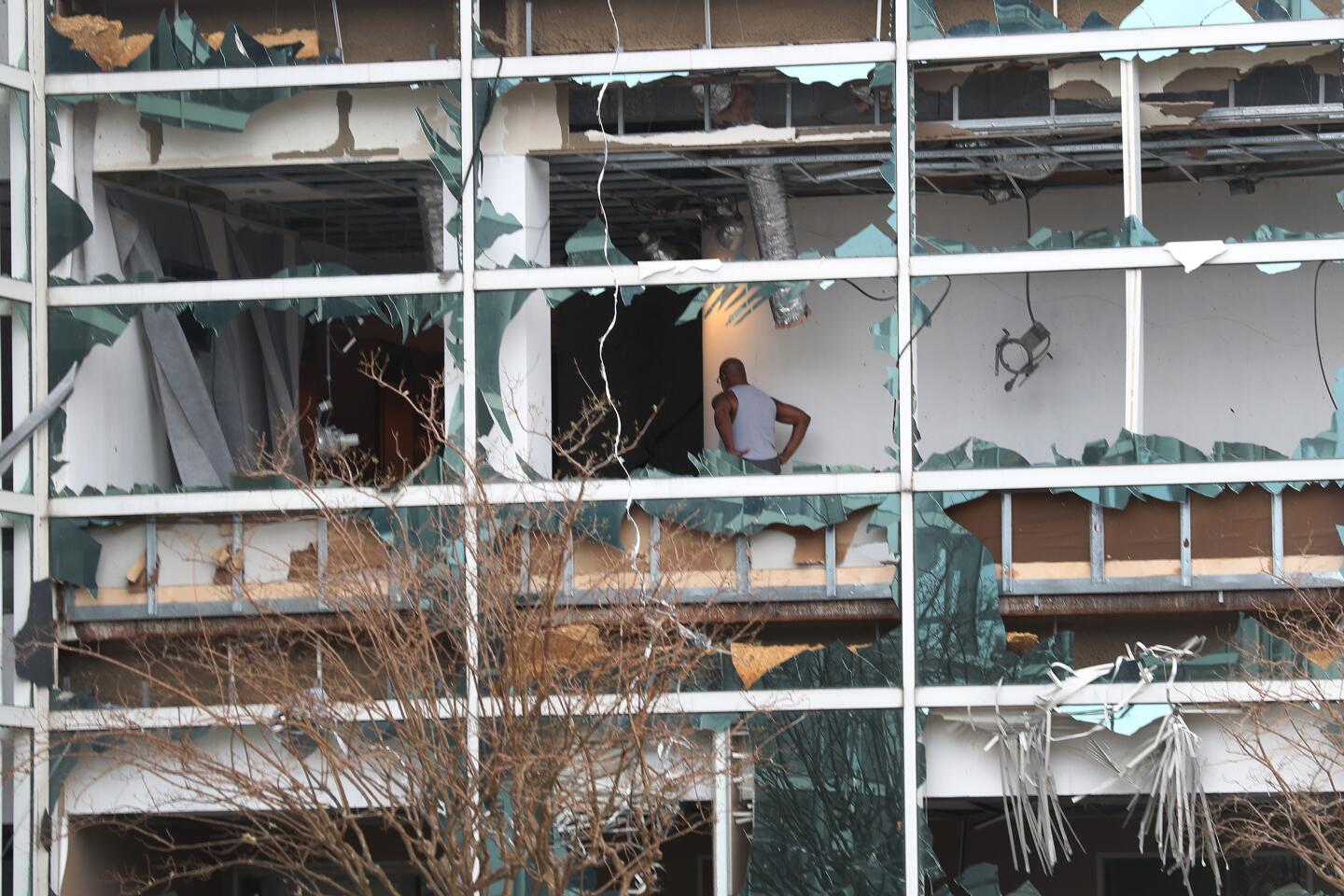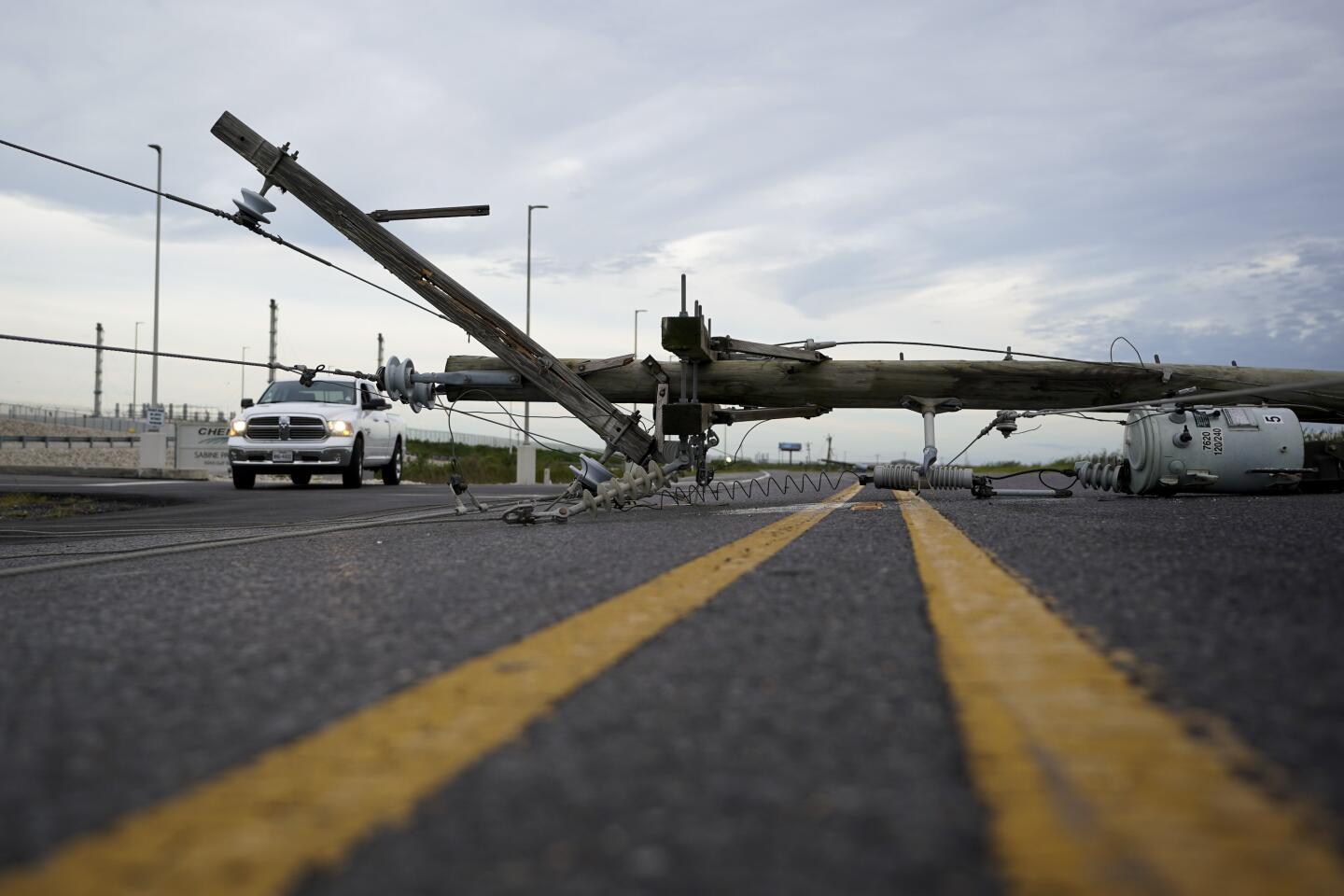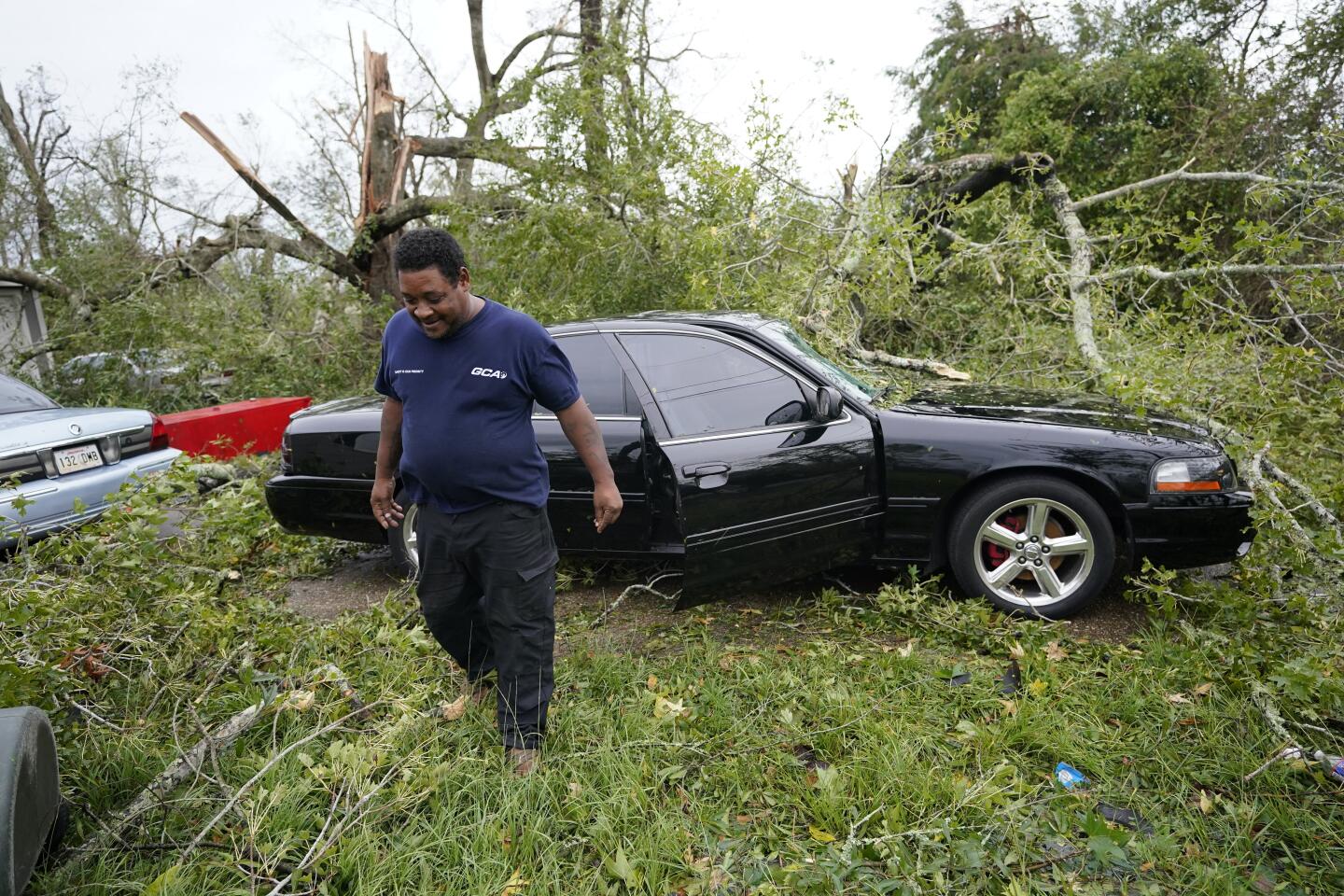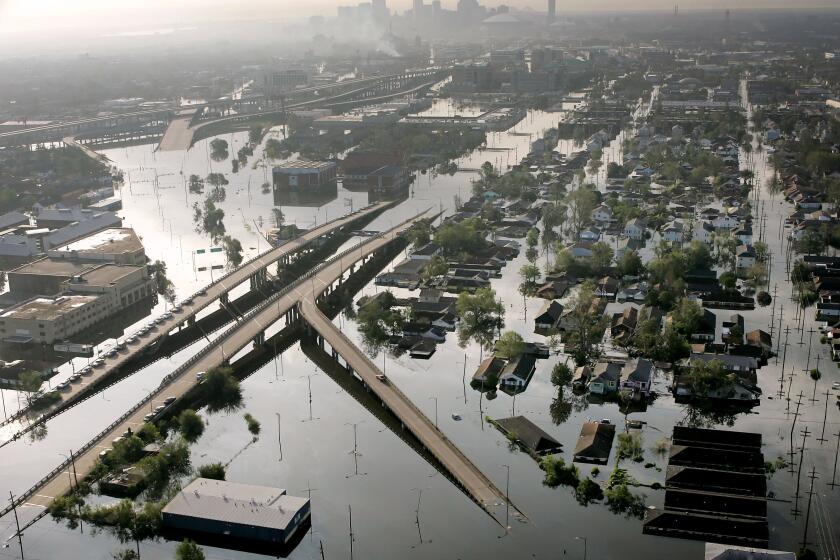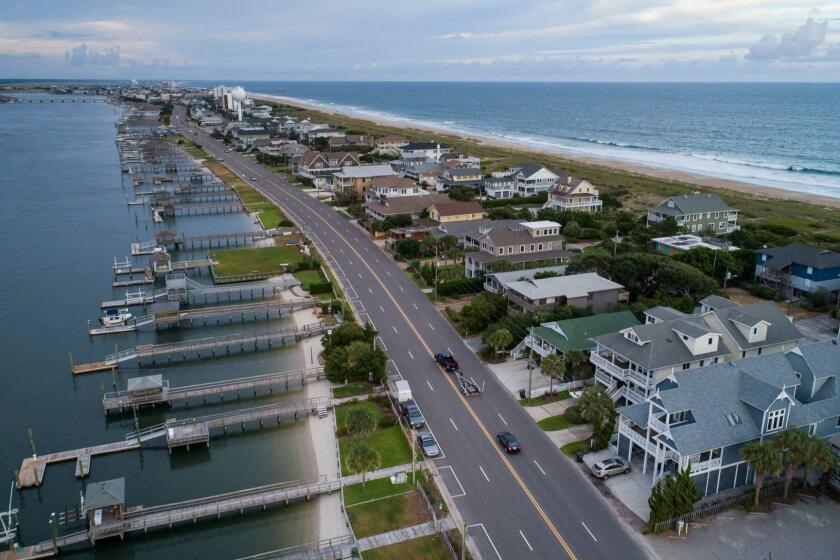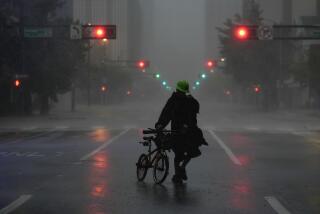Hurricane Laura slams Louisiana coast near Texas with fierce wind, surging sea
HOUSTON — Hurricane Laura slammed into southwestern Louisiana early Thursday, unleashing fearsome winds and torrential rains, shattering windows and knocking out power to hundreds of thousands of households in its destructive path.
Several hours after making landfall as a life-threatening Category 4 storm — the strongest to hit the U.S. this year — Laura’s strength ebbed somewhat and it was reclassified by the National Hurricane Center as a Category 2 hurricane. But with winds of up to 110 mph, the danger had not passed.
As dawn broke Thursday, those who evacuated from the Gulf Coast as Laura approached assessed the damage — and the perils still ahead.
Among the hardest-hit areas was Lake Charles, La., a city of around 80,000 residents about 30 miles east of the Texas border and due north of where the hurricane made landfall overnight. As the storm approached, authorities had warned residents to evacuate as forecasters predicted an “unsurvivable” storm surge of up to 20 feet that is not expected to recede for days.
Charlene Lavergne, 64, didn’t want to leave her home in nearby Sulphur. She had been self-quarantining since the start of the COVID-19 pandemic, leaving only for medical appointments, as infections and deaths spiked in Louisiana. She had also weathered Hurricane Rita there 15 years earlier, a storm of similar magnitude.
But entreaties from her five children and memories of that last deadly hurricane finally persuaded Lavergne to leave.
“I never wanted to see or hear that again,” she said from Plano, Texas, where she was sheltering at a motel with three of her daughters and two grandchildren.
“My family is scattered from San Angelo to Bay City [Texas] to Dallas to Plano to west Houston to Atlanta right now, but we all live in Sulphur,” she said. “My son and his family are trying to go home today and check our homes.”
The most damaging hurricanes, by area of total devastation, are increasing the most, according to a study of 247 hurricanes that hit the U.S. since 1900.
Amanda Wiley Cortez, 48, also evacuated from Lake Charles before Hurricane Laura struck — but had to leave her immunocompromised boyfriend, James Rowe, 51, behind because he refused to leave their mobile home.
As authorities closed Interstate 10 and warned they wouldn’t be able to rescue those who remained until after the storm passed, Wiley Cortez sent a message to the local Calcasieu Parish Sheriff’s Office on Facebook, pleading for them to check on Rowe’s welfare.
But sheriff’s rescues teams had only just started mustering to go out and check roadways for flooding Thursday morning. Wiley Cortez said she hadn’t been able to reach her boyfriend by phone.
“Last I heard from him at 1 a.m., [he] said he was OK. The siding was being blown off of our trailer,” she said. “I’ve tried to call, with no luck. I’m not sure if the cell towers are up.”
Forecasters say they continue to expect a massive storm surge, with large and destructive waves poised to cause catastrophic damage from Intracoastal City, La., including Calcasieu and Sabine Lake, to Sea Rim State Park, Texas.
The biggest surge, up to 20 feet, is expected along a stretch of Louisiana coastline that includes Johnson Bayou and the towns of Holly Beach and Cameron. Forecasters say that this could penetrate up to 40 miles inland from the coastline and that floodwaters won’t fully recede for days.
As a ferocious hurricane bears down on South Florida, water managers desperately lower canals in anticipation of 4 feet of rain.
Laura’s howling winds battered a tall building in Lake Charles, blowing out windows as glass and debris flew to the ground. Police spotted a floating casino that had come loose from its moorings and crunched against a bridge. Hours after landfall, the wind and rain were still blowing too hard to check for survivors.
“There are some people still in town and people are calling ... but there ain’t no way to get to them,” Tony Guillory, president of the Calcasieu Parish Police Jury, the parish’s governing body, said early Thursday morning by phone as he hunkered down in a Lake Charles government building that was shaking from the storm.
Guillory said he hopes those stranded can be rescued later Thursday, but he fears that blocked roads, downed power lines and flooding could delay that process. Officials said search-and-rescue missions would begin as soon as conditions allowed, along with damage assessments.
“We know anyone that stayed that close to the coast, we’ve got to pray for them, because looking at the storm surge, there would be little chance of survival,” Louisiana Lt. Gov. Billy Nungesser told ABC’s “Good Morning America.”
With more than 470,000 homes and businesses without power in Louisiana and Texas, near-constant lightning provided the only light for some.
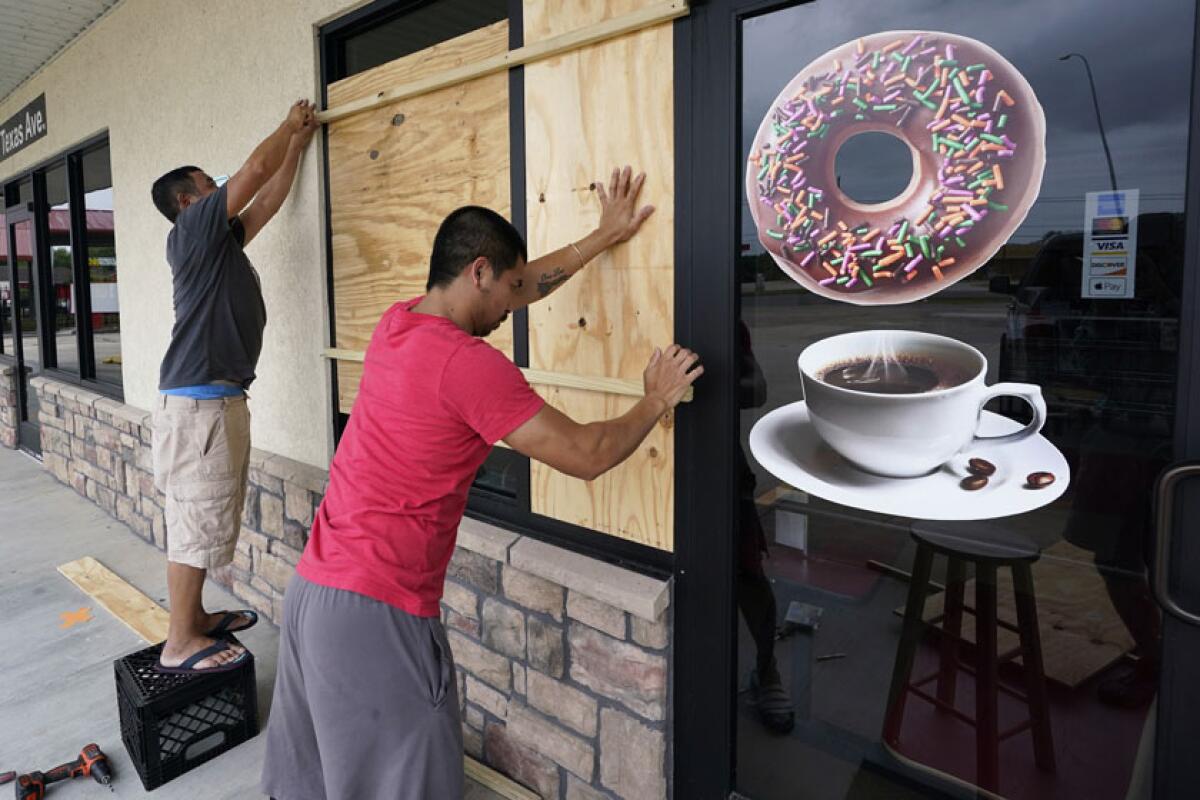
The National Hurricane Center said the storm, which intensified rapidly Wednesday before plowing into land with sustained winds of 150 mph, came ashore at 1 a.m. Central near Cameron, a 400-person community about 30 miles east of the Texas border.
“Potentially catastrophic impacts will continue,” forecasters said in an ominous warning.
More than 580,000 coastal residents were under orders to flee in the largest evacuation since the COVID-19 pandemic began, and many did, filling hotels and sleeping in cars since officials didn’t want to open mass shelters and worsen the spread of the coronavirus.
Govs. Greg Abbott of Texas and John Bel Edwards of Louisiana fretted that the dire predictions were not resonating despite authorities putting coastal residents under mandatory evacuation orders.
Edwards activated the state’s entire National Guard. In Lake Charles, Guard members drove school buses around neighborhoods, offering to pick up families. Across the state line in Port Arthur, Texas, a few stragglers boarded evacuation buses, and city officials announced that two C-130 transport planes offered the last chance to leave.
Officials said at least 150 people refused to leave and planned to weather the storm in shelters including elevated homes and recreational vehicles in coastal Cameron Parish, which could be completely covered by ocean water.
“It’s a very sad situation,” said Ashley Buller, assistant director of emergency preparedness. “We did everything we could to encourage them to leave.”
Abbott warned that people who failed to get out of harm’s way could be cut off from help long after the storm hit.
In 1960, roughly 845,000 people lived in the 24 counties along the Carolina coast.
On Twitter, President Trump also urged coastal residents to heed local officials. Hurricane warnings were issued from San Luis Pass, Texas, to Intracoastal City, La., and reached inland for 200 miles. Storm surge warnings were in effect from Freeport, Texas, to the mouth of the Mississippi River.
For some, the decision to evacuate left them with no place to stay. Wary of opening mass shelters during a pandemic, Texas authorities instead put evacuees in hotels, but Austin stopped taking arrivals before dawn because officials said they ran out of rooms. Other evacuees called the state’s 211 information line and were directed to Ennis, outside Dallas, only to be told after driving hundreds of miles that there were no hotels or hotel vouchers available.
Taniquia Ned and her sisters showed up without money to rent a room, saying the family had burned through its savings after losing jobs because of the coronavirus. “The COVID-19 is just totally wiping us out,” said Shalonda Joseph, 43, a teacher in Port Arthur.
Edwards lamented that the storm meant suspension of community testing for the coronavirus at a crucial time — as elementary and secondary schools in Louisiana are opening and students are returning to college campuses. “We’re basically going to be blind for this week,” the governor said, referring to the lack of testing.
Laura was expected to cause widespread flash flooding in states far from the coast. Flood watches were issued for much of Arkansas, and forecasters said heavy rainfall could arrive by Friday in parts of Missouri, Tennessee and Kentucky. Laura is so powerful that it’s expected to swing eastward and become a tropical storm again once it reaches the Atlantic Ocean, potentially threatening the Northeast.
Toward a more sustainable California
Get Boiling Point, our newsletter exploring climate change, energy and the environment, and become part of the conversation — and the solution.
You may occasionally receive promotional content from the Los Angeles Times.
The hurricane also threatened a center of the U.S. energy industry. The government said 84% of oil production and an estimated 61% of natural gas production in the Gulf of Mexico were shut down and nearly 300 platforms evacuated. Consumers are unlikely to see big price hikes, however, because the pandemic has decimated demand for fuel.
Laura closed in on the U.S. after killing nearly two dozen people this week on the island of Hispaniola — 20 in Haiti and three in the Dominican Republic, where it knocked out power and caused intense flooding.
Laura is the seventh named storm to strike the U.S. this year, setting a new record for U.S. landfalls by the end of August. The old record was six in 1886 and 1916, according to Colorado State University hurricane researcher Phil Klotzbach.
The Associated Press contributed to this report.
More to Read
Sign up for Essential California
The most important California stories and recommendations in your inbox every morning.
You may occasionally receive promotional content from the Los Angeles Times.
